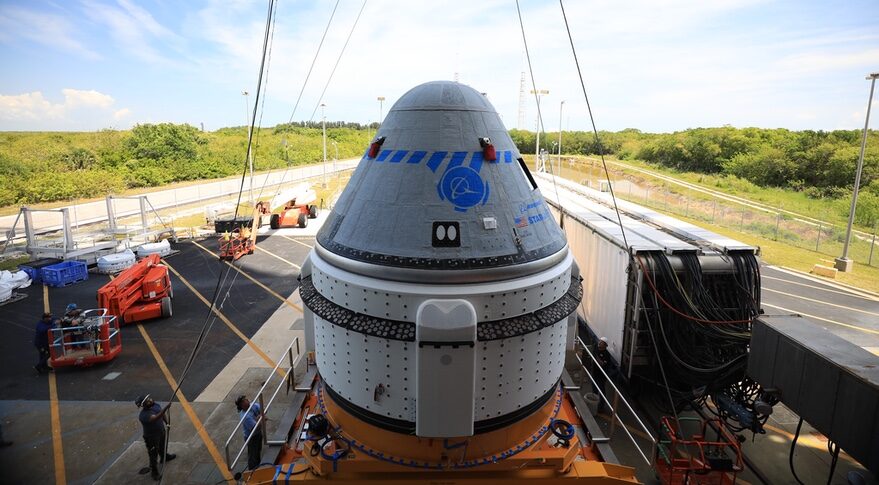
Boeing considering redesign of Starliner valves (Image Credit: Space News)
WASHINGTON — Boeing says it is considering redesigning the propellant valves on future CST-100 Starliner commercial crew spacecraft as a long-term solution to the corrosion problem those valves suffered last year.
At a May 11 briefing about the upcoming Orbital Flight Test (OFT) 2 mission, Boeing’s manager for the program said that while a solution to prevent corrosion of the valves is working for the upcoming mission, a valve redesign is “definitely on the table” as a long-term fix, something the company had not previously acknowledged.
The launch of OFT-2 last August was scrubbed and eventually canceled when more than a dozen oxidizer valves in the spacecraft’s service module failed to open when commanded during pre-launch tests. An investigation by Boeing and NASA concluded that nitrogen tetroxide (NTO) propellant seeped through Teflon seals in the valve and reacted with ambient moisture, creating nitric acid that corroded aluminum in the valve.
Boeing developed a solution to avoid that corrosion that does not make any changes to the valve itself other than sealing an electrical connector that provided a path for moisture to get into the valve. That solution includes loading NTO into the spacecraft later in the processing of the spacecraft to reduce the time it can seep through the valve and doing a dry purge of the valves with nitrogen gas to remove moisture.
Mark Nappi, vice president and program manager of Boeing’s commercial crew program, said at the briefing that the solution, which also includes cycling the valves once every several days, is working. “We have cycled the [oxidizer] valves four times so far,” he said. “They’re working really well.”
However, Boeing said in a statement to Reuters that the company was working on “short- and long-term design changes to the valves.” The statement was in a May 11 story about a dispute between Boeing and the valve supplier, Aerojet Rocketdyne, on the cause of the corrosion, with Aerojet claiming it was caused by a cleaning solution that Boeing used in ground tests of the valve.
Boeing had not previously disclosed plans to redesign the valves. At a May 3 briefing, Michelle Parker, vice president and deputy general manager of space and launch at Boeing, said there were no design changes to the valve for the OFT-2 mission. When asked later about long-term changes, she was noncommittal.
“We have a usable solution for OFT-2. We don’t expect to have any issues,” she said at that earlier briefing. “As always, we’ll look long-term and see if there are improvements to be made — as somebody mentioned, the aluminum housing may be one piece of that — but right now we’re confident in the solution that we have, and we’ll continue to look at future missions.”
Nappi said at the May 11 briefing that Boeing had been considering a redesign of the valve for some time. “The short-term solution has been not to have a redesigned valve,” he said. “For the long-term solution, we’ve been looking at options for at least a month, if not more, and it has included a valve redesign as an option.”
Those plans, he said, depend on ongoing testing. “We’re already looking at different options for CFT,” the Crew Flight Test mission that would follow OFT-2 and be the first mission to carry people. “It’s not been decided what we’re going to do yet, but I can tell you that a valve redesign is definitely on the table.”
Steve Stich, NASA commercial crew program manager, said the agency supported Boeing’s approach of a short-term fix for the OFT-2 mission while continuing to study longer-term changes to the valve. Those changes, he said, could include the use of different materials or different ways to seal the valve.
“We chose to put the mitigations in place that Mark talked about and stay with the qualified valve design,” Stich said. “We can go fly the flight with this. We know this flight is safe to go fly. We know the valves are working.”
The briefing came after a flight test readiness review that confirmed plans for the launch of OFT-2 at 6:54 p.m. Eastern May 19, with a backup launch date of 6:32 p.m. Eastern May 20. Both launch opportunities would allow the uncrewed spacecraft to dock with the International Space Station about 24 hours later. Starliner will remain at the station for several days to carry out tests as well as to transfer more than 200 kilograms of cargo before undocking. The primary landing site for the spacecraft is White Sands Space Harbor in New Mexico, the landing site for the original OFT mission in December 2019.







